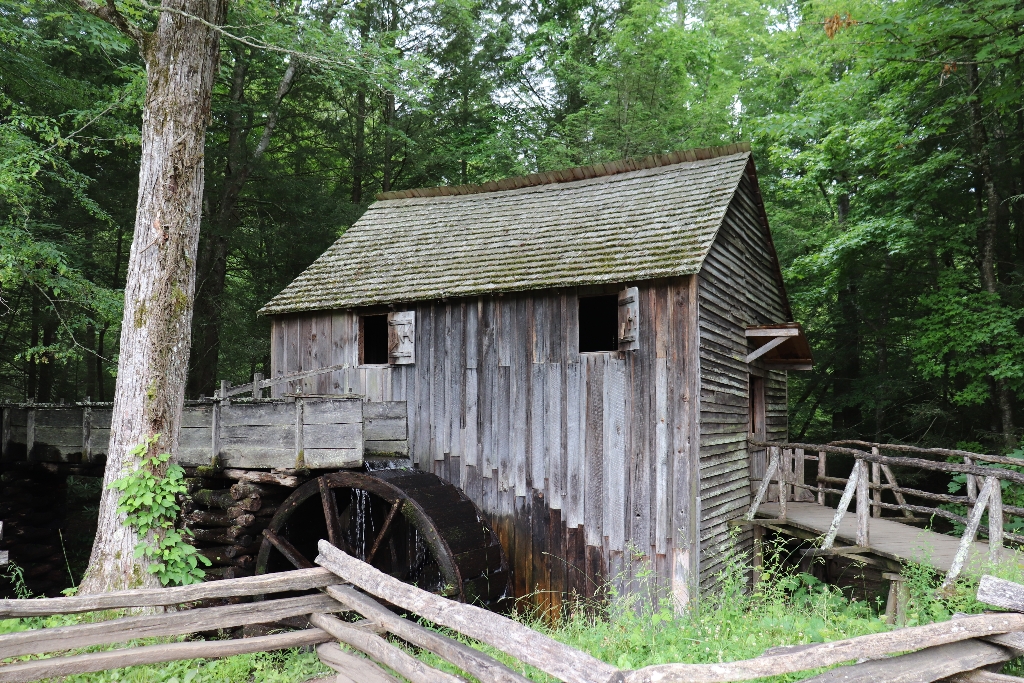
The Cable Mill area contains many of the buildings typical of remote Appalachian farmsteads. The grist mill is on its original site. Other historic buildings in the complex were brought from elsewhere in the park. The blacksmith shop, though typical of old-time blacksmith shops in the Cove, was built in the 1950s.
The Cable Mill has become a symbol for the Cades Cove area of Great Smoky Mountains National Park. John P. Cable built his water-powered grist mill and sawmill around 1870. It was one of several in Cades Cove that served its upwards of 670 residents. Mills played an important role in people’s lives, and families often looked forward to “mill days.” A dam on Mill Creek directs water through a canal to the wooden flume that channels water onto the top of the mill wheel. This activates the mechanism for grinding corn with a mill stone. The same wheel powered a heavy reciprocating blade that cut logs. Such technologies made life easier for Cove residents. Many families had small “tub” mills that could grind enough for a family. However, mills like the one belonging to the Cables were larger and faster, if one was willing to give the miller a share of the grain. Many back-breaking steps required for traditional log cabin-building were removed with mills as well.
Adjacent to the mill is the Gregg-Cable house built in 1879. This is the first and only remaining all-frame house in Cades Cove. All-frame houses were once popular in the cove but were removed after the park was created due to their more modern appearance. The Gregg-Cable house is believed to have been constructed using some of the earliest timber cut on the Cable Mill. A store was operated on the first floor by the Gregg family and later residents, Becky Cable and her brother, Dan Cable. Many of the products necessary for daily life could be purchased there without going to the larger markets of Maryville or Knoxville. Becky and Dan only ran the store for a few years before they sold the contents and turned it into a boarding house. Dan and his wife, Martha, were both ill and they along with their four children lived with and were supported by Becky. After Dan and Martha died, Becky raised their children, which is why she was known to many as “Aunt Becky.”
A smokehouse, corn crib, barns, and sorghum mill stand in the Cable Mill area. Visitors can take advantage of programming here throughout the year. The mill is operated in warmer months. Sorghum-making demonstrations are conducted in the fall, and blacksmithing is done as staffing allows.
The Cable Mill has become a symbol for the Cades Cove area of Great Smoky Mountains National Park. John P. Cable built his water-powered grist mill and sawmill around 1870. It was one of several in Cades Cove that served its upwards of 670 residents. Mills played an important role in people’s lives, and families often looked forward to “mill days.” A dam on Mill Creek directs water through a canal to the wooden flume that channels water onto the top of the mill wheel. This activates the mechanism for grinding corn with a mill stone. The same wheel powered a heavy reciprocating blade that cut logs. Such technologies made life easier for Cove residents. Many families had small “tub” mills that could grind enough for a family. However, mills like the one belonging to the Cables were larger and faster, if one was willing to give the miller a share of the grain. Many back-breaking steps required for traditional log cabin-building were removed with mills as well.
Adjacent to the mill is the Gregg-Cable house built in 1879. This is the first and only remaining all-frame house in Cades Cove. All-frame houses were once popular in the cove but were removed after the park was created due to their more modern appearance. The Gregg-Cable house is believed to have been constructed using some of the earliest timber cut on the Cable Mill. A store was operated on the first floor by the Gregg family and later residents, Becky Cable and her brother, Dan Cable. Many of the products necessary for daily life could be purchased there without going to the larger markets of Maryville or Knoxville. Becky and Dan only ran the store for a few years before they sold the contents and turned it into a boarding house. Dan and his wife, Martha, were both ill and they along with their four children lived with and were supported by Becky. After Dan and Martha died, Becky raised their children, which is why she was known to many as “Aunt Becky.”
A smokehouse, corn crib, barns, and sorghum mill stand in the Cable Mill area. Visitors can take advantage of programming here throughout the year. The mill is operated in warmer months. Sorghum-making demonstrations are conducted in the fall, and blacksmithing is done as staffing allows.
Is there something we missed for this itinerary?
Itineraries across USA

Acadia

Arches National Park

Badlands

Big Bend

Biscayne

Black Canyon Of The Gunnison

Bryce Canyon

Canyonlands

Capitol Reef

Carlsbad Caverns

Channel Islands

Congaree

Crater Lake

Cuyahoga Valley

Death Valley

Dry Tortugas

Everglades

Gateway Arch

Glacier

Grand Canyon

Grand Teton

Great Basin

Great Smoky Mountains

Guadalupe Mountains

Haleakalā

Hawaiʻi Volcanoes

Hot Springs

Indiana Dunes

Isle Royale

Joshua Tree

Kenai Fjords

Kobuk Valley

Lassen Volcanic

Mammoth Cave

Mesa Verde

Mount Rainier

North Cascades

Olympic

Petrified Forest

Pinnacles

Rocky Mountain

Saguaro

Shenandoah

Theodore Roosevelt

Virgin Islands

Voyageurs

White Sands

Wind Cave

Yellowstone

Yosemite

Zion